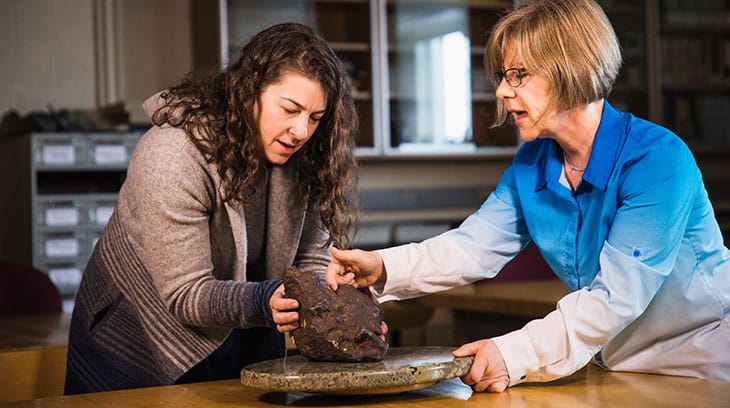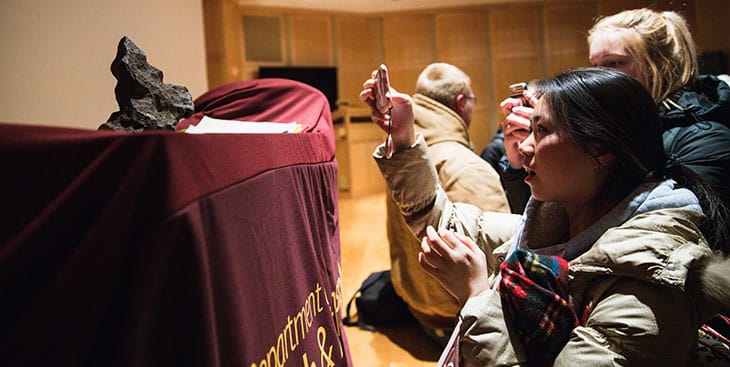Meteorite makes fresh impact
Smithsonian geologist who confirmed discovery at CMU draws a crowd
Before a standing-room-only crowd in Park Library, Central Michigan University earth and atmospheric sciences faculty member Mona Sirbescu welcomed a visiting guest of honor.
"Thank you so much for traveling all over from the asteroid belt to be with us on Planet Earth," she said with a smile to the Edmore meteorite, the former doorstop she famously identified in 2018 as a rock from outer space.

The 22-pound chunk of iron and nickel rested on a cart in front of her on the Opperman Auditorium stage. It shared top billing with the event's flesh-and-blood star: geologist Catherine Corrigan, curator of Antarctic meteorites at the Smithsonian National Museum of Natural History.
A Michigan native and onetime CMU instructor, Corrigan helped authenticate and analyze the Edmore meteorite in Washington, D.C., after Sirbescu sent her a slice of the rock. Her visit Thursday was her first chance to see the entire meteorite in person.
Corrigan spoke to the crowd of nearly 150 about the Edmore and how meteorites offer clues to the formation of the solar system. She also shared her experiences collecting hundreds of samples near the South Pole through the Antarctic Search for Meteorites program.
In the audience was Edmore meteorite owner David Mazurek from Grand Rapids, Michigan. He brought the rock to Sirbescu for analysis last year and was awestruck to find it could be worth tens of thousands of dollars to a museum or collectors.
How it got here
Meteorites are rocks from space that make it to Earth's surface. There are many types.
The Edmore, classified as a IIIAB iron meteorite, is a 4.5 billion-year-old relic from the once-molten core of an unknown asteroid between the orbits of Mars and Jupiter, Corrigan said.
At some point, the destruction of that asteroid launched the Edmore on the trajectory that brought it eventually to Earth, where probably half of its mass burned up as it screamed through the atmosphere one night in the 1930s.
A farmer and his son dug the still-warm rock out of its impact crater near Edmore, Michigan, and passed it to its current owner when the farm changed hands in the 1980s.
The rock is comparable to the composition of the Earth's core in some ways, Corrigan said, which makes it valuable to science "because we're never going to be able to get a piece of that."
But it also bears features found in no rocks formed on Earth: As it cooled in deep space by about a degree and a half every million years or so, the metal crystallized in a distinctive geometric pattern that can be seen in cross section.
The Antarctic project has collected 23,000 meteorites in 42 seasons of searching, but in Michigan the Edmore meteorite is one of only 12 ever found.
Even so, Corrigan told her audience, every now and then they show up in surprising ways.
"They might be holding open your barn door," she said. "They might come crashing through your roof.
